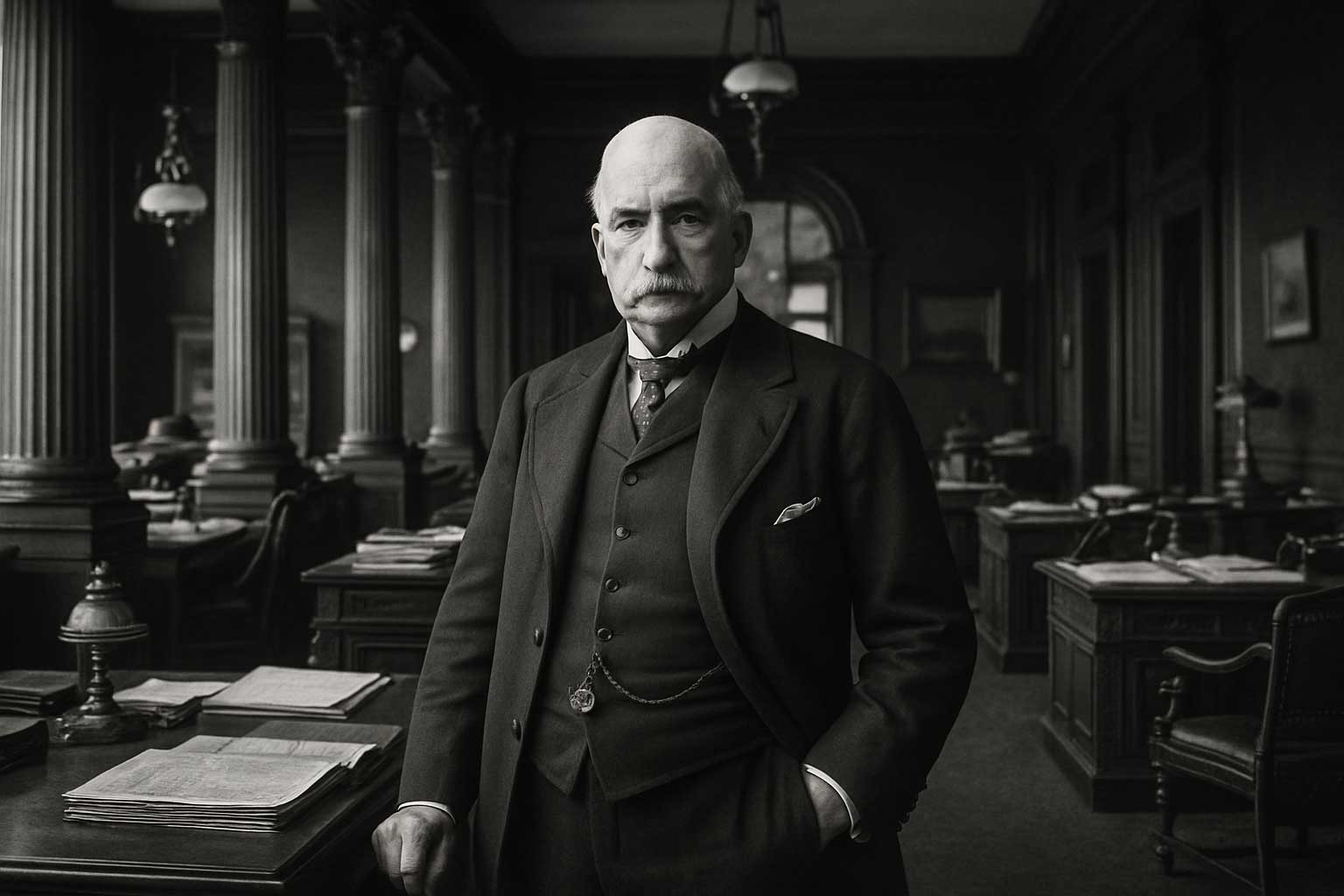Born: April 17, 1837 — Died: March 31, 1913
Born to wealth. Died owning Wall Street.
J.P. Morgan turned high finance into high power. With deep roots in transatlantic banking, he built an empire that didn’t just fund America’s growth—it directed it. He reorganized industries, stabilized markets, and became the man governments called when capitalism started to crack. J.P Morgan didn’t follow the rules. He set them.
Facts & Figures
| Category | Details |
| Born | April 17, 1837, Hartford, Connecticut |
| Banking Dynasty Start | Drexel, Morgan & Co. (1871) |
| Formed General Electric | 1892 (merger of Edison GE and Thomson-Houston) |
| Created U.S. Steel | 1901 (acquired Carnegie Steel for $480M) |
| Controlled Railroads | Over 5,000 miles of lines |
| Panic of 1907 Response | $25M personal pledge to stabilize the economy |
| Peak Influence | Controlled ~$1.3B in assets (early 1900s dollars) |
| Personal Art Collection Value | Over $50M at time of death (later core of The Met) |
J.P Morgan’s Rise: Born Into Capital, Built an Empire
J.P Morgan started in his father’s firm (J.S. Morgan & Co.) and launched Drexel, Morgan & Co. in 1871—later rebranded as J.P. Morgan & Co., a name that still echoes in modern finance. He combined European capital with American ambition, and from there, his playbook was simple: consolidate industries, eliminate inefficiencies, and control outcomes.
In a time when railroads were crumbling from mismanagement, Morgan stepped in—not with theory, but with capital and control. He restructured railroads, installed trusted executives, and forced cooperation between rivals. His methods weren’t always subtle—but they were effective.
He Didn’t Just Fund Industry—He Forged It
- General Electric was born in 1892 when J.P Morgan merged Edison General Electric with Thomson-Houston. Today? It’s one of the most iconic industrial companies on Earth.
- He backed and later controlled U.S. Steel, created from the $480 million acquisition of Carnegie Steel—the first billion-dollar corporation in history.
- Controlled over 100 corporations across railroads, steel, utilities, and banking.
Morgan wasn’t afraid to get in the weeds or swing the axe. He often bought out competitors, then installed his own men at the top—replacing chaos with hierarchy.

Panic of 1907: When the Government Couldn’t, Morgan Did
In 1907, the U.S. banking system nearly collapsed. The Federal Reserve didn’t exist yet. The U.S. Treasury was powerless.
Enter J.P. Morgan.
In a smoke-filled Manhattan library, Morgan locked the doors on Wall Street’s top bankers and forced a bailout. With surgical precision, he stabilized major trust companies, propped up the New York Stock Exchange, and even coordinated a buyout of the collapsing Tennessee Coal, Iron and Railroad Company—absorbed into U.S. Steel in record time. Morgan didn’t ask permission. He acted. And in doing so, he kept the American economy alive.
Power Beyond Elected Office
Morgan had no public office—but more power than most presidents. His signature move was “Morganization”—a method of absorbing chaotic industries and rebuilding them under centralized control, often with him pulling the strings.
Presidents respected him, feared him, or both. Theodore Roosevelt, no stranger to challenging power, once said of Morgan:
“A man like Morgan… is at least a man to be reckoned with.”
Congress eventually forced him to testify during the 1912 Pujo Committee hearings on banking concentration. He walked into that room owning more of America than anyone in the room combined.
Legacy: Banking Blueprint and Cultural Capital

J.P. Morgan’s personal empire helped birth what became modern corporate finance and set the stage for the Federal Reserve, which was created just months after his death in 1913.
His personal bank, J.P. Morgan & Co., is now part of JPMorgan Chase, the largest U.S. bank and one of the most powerful financial institutions in the world.
And he didn’t just stack wealth, he curated culture. His rare books, art, and manuscripts formed the foundation of The Morgan Library & Museum, a New York institution.
The Morgan Bloodline
J.P. Morgan’s son, J.P. Morgan Jr., inherited the empire but never matched his father’s swagger. The younger Morgan modernized operations and financed the Allies during WWI, but the days of Morganization and the ability for a banker to hold the entire system in his hands were fading.
Morgan Sr. didn’t just build a financial empire—he shaped capitalism’s rules of engagement. Control the capital, control the outcomes. That’s legacy.
Why J.P. Morgan Belongs in the Inspired Founders Hall of Fame
J.P. Morgan didn’t just play the game, he ran the board. When American capitalism was chaotic and unregulated, he brought structure, scale, and sheer authority. He built empires like U.S. Steel and General Electric, stabilized Wall Street when the government couldn’t, and defined what modern finance would become. His legacy is the backbone of corporate America. That’s Hall of Fame status, no question.
Back to the Inspired Founders Hall of Fame
J.P. Morgan didn’t just earn a seat in the Inspired Founders Hall of Fame—he owned the table. When the system broke, he fixed it. When industries faltered, he merged and managed them into relevance. His influence isn’t just in Wall Street history, it’s baked into every deal, fund, and merger that happens today.
Further Reading & Official Resources
J.P. Morgan
- The Morgan Library & Museum – Explore Morgan’s personal collection of rare manuscripts, books, and art in what was once his private library.
- JPMorgan Chase Heritage – Learn more about the legacy and evolution of his financial empire.
- Federal Reserve History: Panic of 1907 – A breakdown of Morgan’s critical role in stabilizing the U.S. economy.






